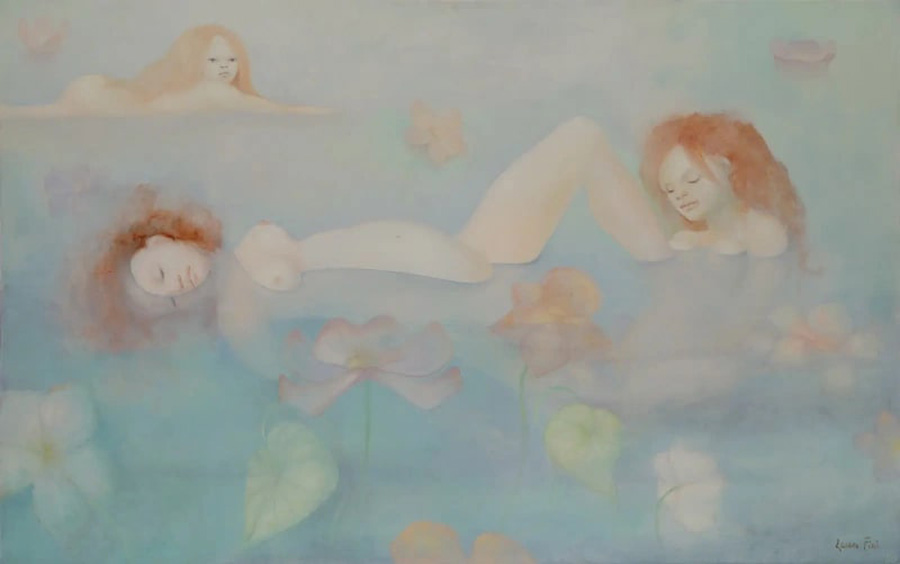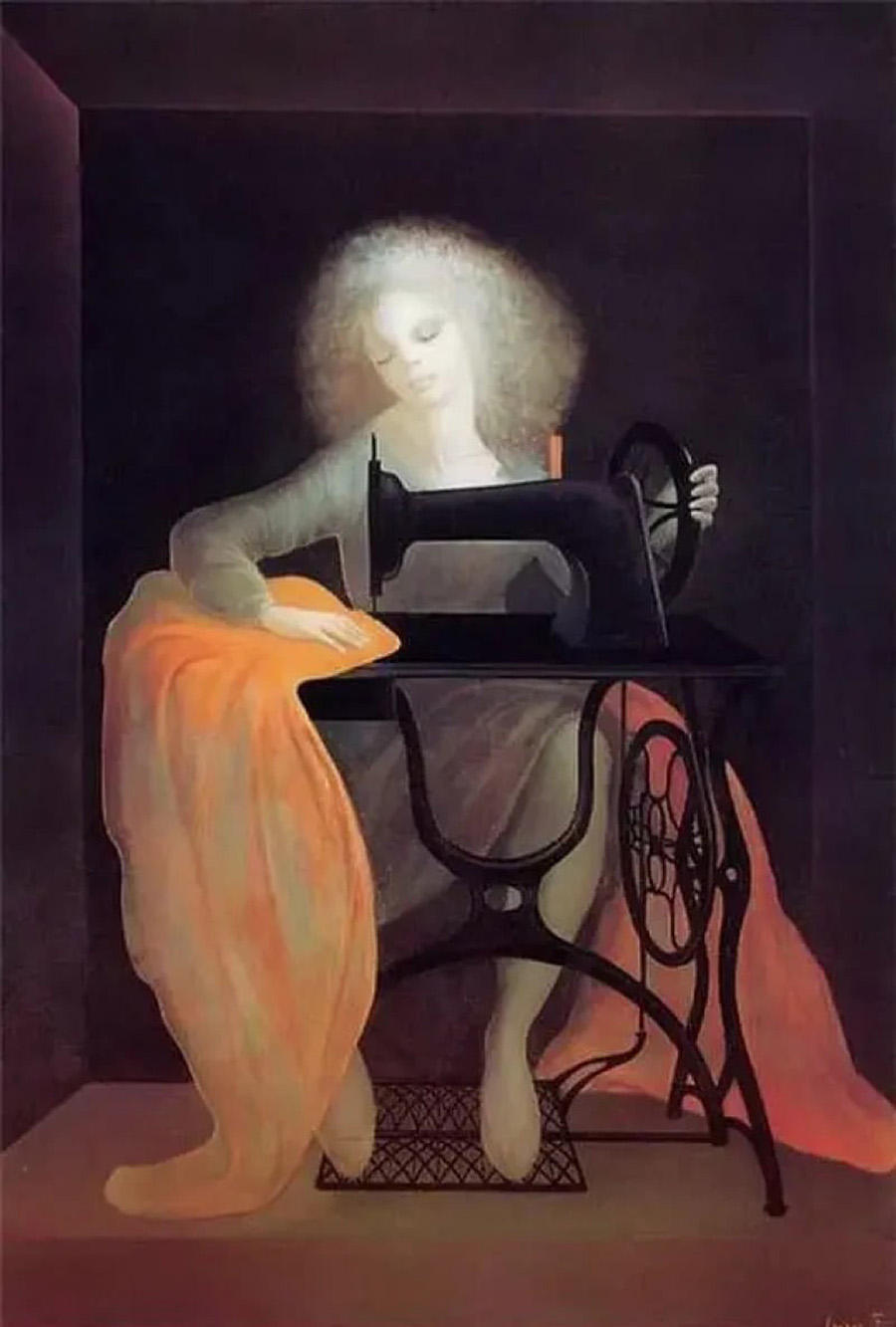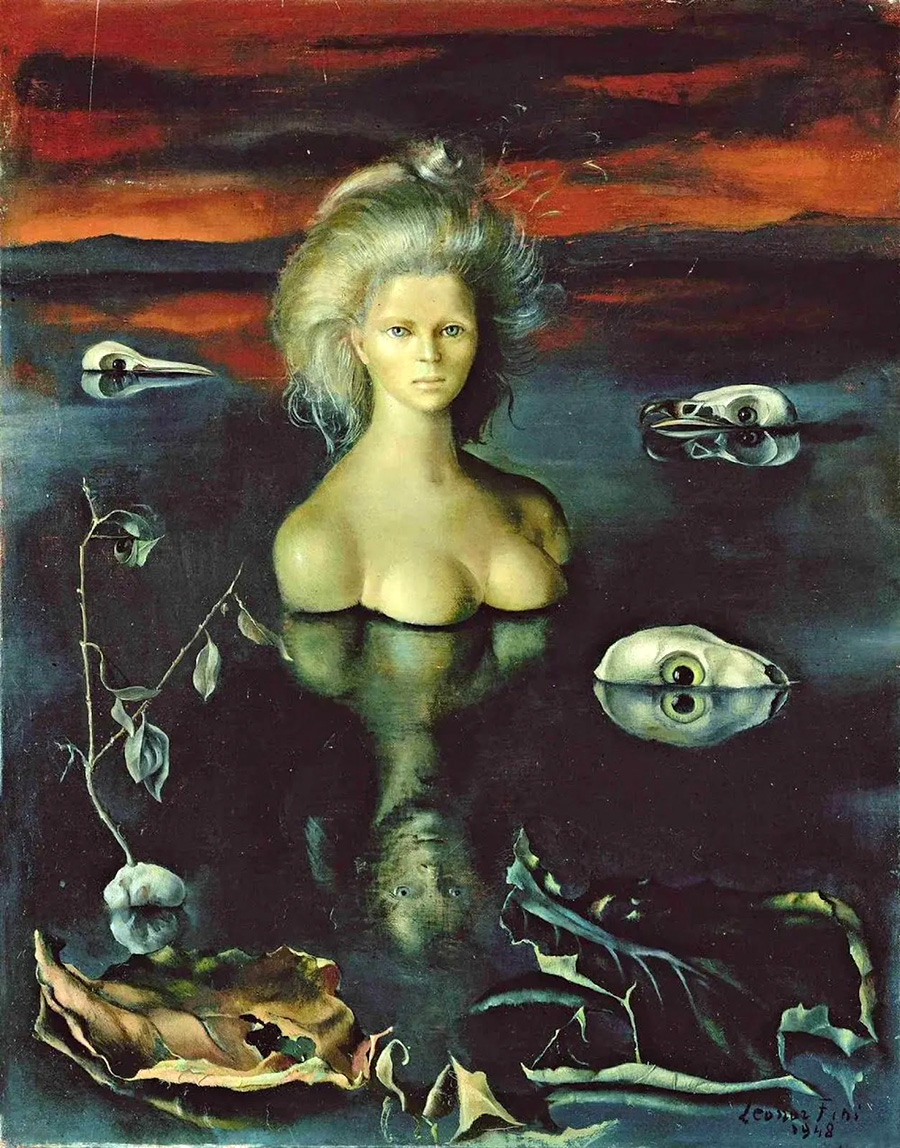
Born in Argentina, she had an Italian temperament and became known and recognized in France. Leonor Fini can rightfully occupy one of the leading lines among the outstanding artists of the twentieth century. She was one of the brightest representatives of the pre and post-war avant-garde, represented the Parisian school.
Art historians are sure that many artworks were a way of self-presentation, even the repulsive in her performance seemed refined and extravagant.

Sunday afternoon
The specificity of her work was a mixture of surrealistic view of eroticism, notes of magical realism and symbolism, androgynous male figures and dominance of female images. On her canvases one can see a slightly gloomy world with surrealistic subjects, an abundance of hidden metaphors and fantastic creatures.
Among the most iconic artworks are the canvases "The Blind", "Ideal Life", "Figures on a Terrace", "Self-Portrait with a Scorpion", "Woman Sitting on a Naked Man". Worthy of attention are canvases from the "Wagon Cycle", her series of illustrations for the novels of Pauline Réage and the Marquis de Sade.

Bathers
The family of the future artist was difficult to call happy. Her father was an Argentinean, in whose veins flowed and Russian blood, her mother - Italian. Because of her husband's tendency to tyranny, Leonor's mother took her one-year-old daughter and moved to her parents in Trieste.
Leonor was characterized by an inquisitive mind, excellent learning ability, intelligence and freedom-loving. She did not like dogmas, dictates, and therefore at the age of fifteen years she dropped out of school and began to receive education at home, study books, visit museums. She began to draw early, but did not receive professional education and was a talented nugget, self-taught like Arkhip Kuindzhi or Niko Pirosmani.
The style and taste of the artist was formed under the influence of Flemish, German painting of the XV century, she was inspired by Italian Mannerism, she admired the work of Klimt, Schiele. The artist began to paint seriously when she became ill and had to wear a tight eye patch. The lack of visual images awakened her imagination, and visions that would be reflected in Leonore's manner and artwork throughout her life.

Self-portrait with a large collar.
The artist was only seventeen when her artwork was exhibited in Trieste. They were appreciated, began to order portraits, she began to earn her first money. However, the young, temperamental girl was cramped and bored in a small town, so she went to Milan, which was the Italian cultural capital.
At first, her artwork will appear in collective expositions together with other artists - she has not yet grown up to personal exhibitions.
Characterized by an inquisitive and restless mind, the young artist could not live in one place for long. In the early 1930s Leoron decided to move to Paris, which seemed so mysterious and attractive.

Temptation
The temperamental, eccentric, flamboyant artist quickly fits into the Surrealist milieu. She makes friends, admirers, including Gala and Salvador Dali, Picasso, Ernst and many others. But with Andre Breton, who was considered the leader of the Surrealists, the artist could not find a common language. Why? He was too authoritarian, did not want to take seriously the work of women artists.
In those days, men considered creativity their prerogative and tried to push women into the background. Cooking, housework, raising children - that's a woman's job, and leave creativity to men, because they know it much better - a typical opinion of many, even the most liberal artists, art historians and gallery owners.

A sewing machine
This is probably why Leonore did not want to be considered a surrealist painter. She wanted to express her view of female attractiveness, the essence of the female soul, psychology and attitude to life. On her canvases she destroyed gender roles and social attitudes, demanding the right to express herself.

Face
Despite all the obstacles, the artist's artwork would appear at almost all important Surrealist exhibitions. In Paris there will be a personal exhibition of Leonore's artwork in a gallery owned by Christian Dior and Julien Levy, who had not yet become famous.
By 1936, the artist began to talk about the ocean. She was invited to exhibit artwork at the New York Gallery. The same exhibition featured artwork by American Surrealists and Max Ernst. Julien Levy in a few years will hold a solo exhibition Leonore.
The Second World War began. The artist was forced to leave the capital and settle in Monte Carlo. There she met Italian diplomat Stanislao Lepri, who would become her lover.

Portrait of Stanislao Lepri
He will not be the only one, because Leonor is too bright and fascinating nature. A little later in her life will appear a publicist of Polish origin Konstanty Elenienski.
Together with Lepri the artist goes to the capital of Italy, where she feels happy. Her artwork is exhibited in the gallery of American Peggy Guggenheim, she took part in the exhibition "31 Women". Peggy Guggenheim suggested looking at art and surrealism as only ladies see it. Leonore was the first to dare to create erotic paintings and show them to the public. It was a very daring thing to do. The painting "Woman Sitting on a Nude Man" was praised by many, although there were those who were not happy with such a provocative artwork.

A woman sitting on a naked man.
The war was over. The artist returned to Paris, and again engaged in his favorite work. In the early fifties in the life of Leonor will appear Constantius. The previous relationship also did not end, and until the end of days non-standard "family union" will consist of three people. Later she will say that in this relationship was a lot of epatage, passion, theatricality, as in her artwork.

The end of the world
Fini was too versatilely gifted to limit herself to paintings. She had time to try easel art, object design, scenography, created illustrations for books, was fond of designing theater, ballet, opera costumes, created outfits for films. Leonor literally blossomed and gained strength from recognition, the opportunity to make friends and enjoy popularity among great contemporaries who were delighted with her strength, temperament, intelligence.

Leonor Fini and Brigitte Bardot before going to the Surrealist Ball
Artwork for more than 60 years, the artist created canvases that emphasized the beauty and freedom of nude ladies and their desires. She fought for women's rights and the opportunity to challenge the gender roles imposed by men for centuries. The warrior, sphinx women in her paintings often aroused the surprise and admiration of the public. Even with her private life, she challenged society.

Shepherdess of the Sphinxes
Lifetime retrospectives of Leonor's artwork appeared in Japan, Belgium, Paris, and Italian cities. But in the mid-1990s, after the artist's death, her work was forgotten for some time. Only recently the public has again become interested in the amazing artwork of the talented lady. Now Fini is called a brilliant representative of surrealism, one of the first and bright feminists. And yet many art historians are convinced that Leonore's influence on avant-garde art is yet to be discovered and understood more deeply.
Buy handmade goods or modern art you can on artAlebrio - is an international marketplace for people who want to create, sell, buy and collect unique items and art - buy the best with us artAlebrio.com.
By confirming your order you unconditionally accept these General Conditions of Sale